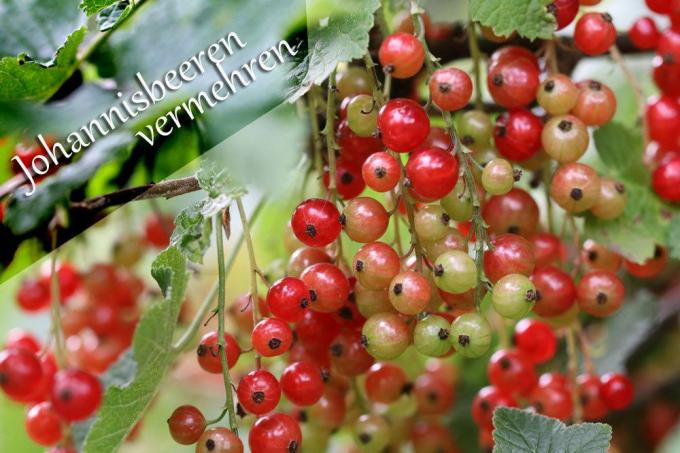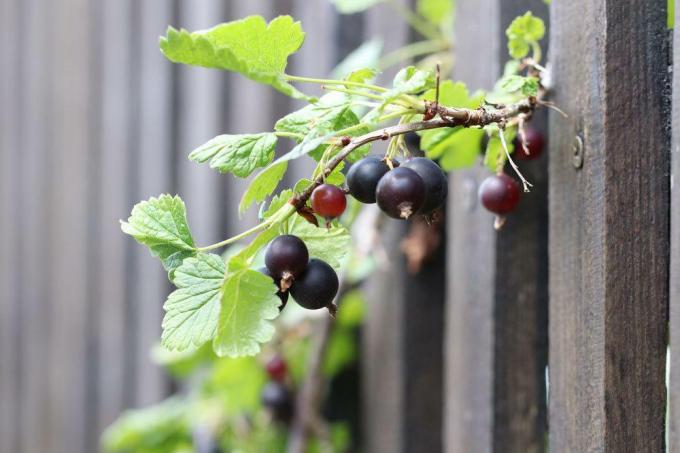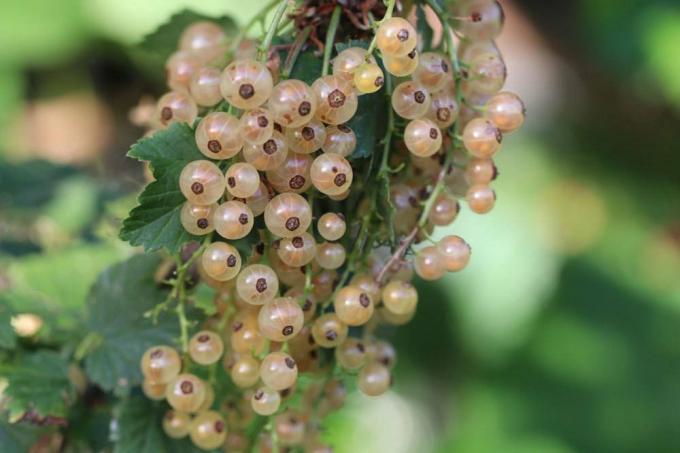
table of contents
- Propagate currants
- Propagation via cuttings
- instructions
- Propagation via offshoots
- instructions
- Propagation by sowing
- Seeds
- instructions
Currants belong next to blueberries and Raspberries the most popular berry bushes among Germans and thrive in their own garden without any problems. The trees grow gradually from year to year and with good care you can look forward to a large amount of berries that you can use for numerous dishes. It is precisely for this reason that many gardeners find it interesting to know in which ways the plants can be propagated.
Propagate currants
A currant alone in the garden looks a bit sparse, especially if you want a wild hedge that should gradually enlarge. The gooseberry family (bot. Grossulariaceae) belong to those woody plants due to their vigor and unpretentious attitude, which even in large numbers in the garden do not become too strenuous for the gardener. For these reasons, it makes sense to propagate your own currants in the garden in order to enjoy the plants even more. You can also pull yourself a completely new specimen through the different types of propagation if you are not yet a proud owner of a currant yourself. The following species are suitable for propagation:
- Red currant (R. rubrum)
- Black currant (bot. R. nigrum)
- Mountain currant (bot. R. alpinum)
- Blood-red currant (bot. R. sanguineum)
- Gold currant (bot. R. aureum)
These species are the typical taxa that thrive in the native latitudes. There are numerous other species that are either not available as seeds or for which it can even get too cold in Germany or Central Europe. If you want to grow currants for a rich harvest, you should choose the black variety. This ensures the highest and at the same time safest yields, especially if the location of the plant is right. At the same time, all species are quite unsusceptible to pests and diseases if you don't neglect their care. Whichever species you choose, the same methods are used to multiply.

tip: The gooseberry (bot. Ribes uva-crispa), despite its name, can be propagated in the same way as currants. The reason for this is belonging to the genus Ribes, which distinguishes gooseberries with similar vegetative and generative characteristics.
Propagation via cuttings
In the case of currants, propagation via cuttings has proven to be particularly effective. The reason lies in the growth of the plants, because even the cuttings take root within a short time and enables certain success in the majority of cases, even if you do not take care of the plants are well versed. Propagation via cuttings is the preferred variant and for this you only need cuttings that have the following properties:
- Length: 10 to 15 centimeters
- below and above a bud
- annual
Make sure that the buds are still on the cutting, otherwise the wood cannot sprout again and will ruin your attempt. The best time for that cut the cuttings are either spring or autumn, since the currants are the largest at this time Share of juice flow, which has a positive effect on the germination capacity and growth of the cuttings will. You should only cut the cuttings with sharp, disinfected scissors to avoid infections. These could cost you dearly. Once you have your cuttings ready, follow these instructions to plant them step by step.
instructions
1. To propagate the currants, choose either spring or autumn. As when cutting the cuttings, these times are ideal for propagation. Choose a day without snow to make it easier for you to plant the cuttings.
2. The location for the cuttings should be a bed or a tub that is in the shade. No sun is needed until roots are formed and the plants are moved once they are big and strong enough. Choose soil that is loose and permeable as the substrate for the cuttings. If this is humic, the cuttings can take root even more easily. You can mix compost into the soil to improve the soil quality of the bed.
3. Take the cuttings and place them close together in the soil. Simply stick this halfway directly into the earth and fix the location so that the wood is not blown over.
4. Now leave the woods in the ground until they take root, which can be recognized by the first leaf shoots. On average, this takes a whole season. As soon as the young green shows, you should carefully remove all the wood from the earth and check the ends for sore tissue (callus) or roots. Keep only those specimens and dispose of the others in the compost.
5. Now plant them in the desired place or in a larger pot. Make sure that there are planting distances of 20 to 30 centimeters from plant to plant and row to row. From this point on, you care for the bushes in the usual way. The great advantage of this type of propagation is that the young plants are 100 percent pure.

tip: Propagation over cuttings is ideal if you want to raise your ribes as a high trunk, where you remove the lower shoots as usual to form a crown. You need long gold currant rods for this type of husbandry, which must be rooted and can be used as a base for grafting.
Propagation via offshoots
In addition to cuttings and sowing, propagation by cuttings is another way of propagating your own currants. This happens in spring. Choose a young, annual shoot that can bend from top to bottom, right down to the bottom. This must not kink and should not be sick or weak.
instructions
Once the right shoot has been selected, follow these instructions to propagate your currant using an offshoot:
- Bend branch on the ground
- should run in a gentle curve
- Bury branch in one place in the ground
- Cover the offshoots with a layer of sawdust beforehand
- press the earth lightly
- moisten
- Maintain the mother plant as usual
- Prepare a new location or bucket in autumn
- Cut off behind covered offshoots with scissors
- Check offshoots for roots
- replant
In this way you get a 100 percent pure currant that you can plant in the garden without any major problems. Propagation of cuttings is a good method if you don't have a free bed or tub to start with.
Propagation by sowing
The sowing of currants is listed as the last variant for propagating currants, as this is a difficult topic. The reason for this is the seeds of each variety that you have chosen to grow. Sown seeds of Ribes, like all plant and animal organisms, are subject to Mendel's rules, in this case the 2nd Rule, the split rule. In this case, the offspring of the woody plants are no longer uniform, i.e. corresponding to the original variety, but can combine characteristics of other varieties or represent a completely different variety. This is especially the case with currants, which are often jealous of this rule. Reasons for this are:
- Pollinators
- Birds
- Wildlife
In themselves they are currant bushes self-fertilizing and in most cases would not have to resort to pollinators or animals to expand their populations. In this case, however, the harvest would be significantly less, which many gardeners do not want. For this reason, it is often recommended to plant several different varieties together so that they can pollinate one another and thus significantly increase the number of fruits. At the same time, this form of pollination ensures that the varieties exchange their genetic material with one another and that a completely different variety will emerge in the next generation. You need to consider this issue when you are looking for the propagation Gooseberry plants are of interest: Only in exceptional cases will you get exactly the variety you want, the You have sown. Furthermore, you have to consider the following disadvantages of sowing:
- lower yield
- weaker taste
- more often sour in the aroma
In many cases, the benefits outweigh the benefits of propagating the bushes, as the results are only satisfactory in a few exceptions.
Seeds
If you don't use cuttings or cuttings yourself or if you are curious which variety will show up, nothing stands in the way of using seeds. For this you only need seeds, which cost on average between two and four euros per 15 to 20 seeds. These prices are independent of the species, as long as it is a local one. When it comes to seed propagation, it is best to rely on R. nigrum, as these achieve the greatest success and are not quite as intensely acidic as other variants. Alternatively, you can take seeds from the berries, remove the pulp, wash and dry them. Then, follow these cuts that tell you how to grow currants from seeds.
instructions
1. Start by stratifying the seeds. This is understood to be a cold stimulus that increases the germination capacity of the seeds. Before winter, the seeds are either packed in a freezer bag with sand, moistened and Put it tightly closed in the refrigerator or in a mixture of compost and soil directly in the bed sown. The compost should be moist enough because that way the seeds won't start to dry out over the winter.
2. Check over the winter, the best period for stratification is from December to February, every now and then the sand or the earth. If necessary, moisten them a little so that the seeds do not dry out. That wouldn't do the currants any good.
3. Wait until spring, March or April, depending on the temperatures in your area. Unpack the seeds and sow them in the bed. The place should meet the location requirements of currants as described above.
4. If the first seedlings appear, wait until the first pairs of leaves have formed. Then look at the individual plants and sort out those that appear too weak or dry. You should also dispose of any specimens that have been shot.
5. From this point on, you don't need to do anything other than maintenance. Currants are very robust and in most cases grow without any problems. If necessary, you can even plant the specimens in the tub if you want portable shrubs.





